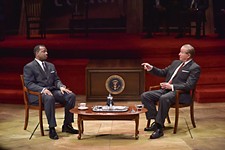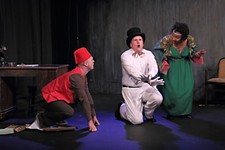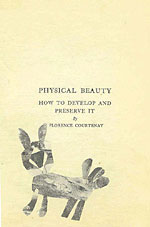St. Enid and the Black Hand
In Vortex Repertory Company's mesmerizing St. Enid and the Black Hand,' an archetypal family enacts a fairy tale with many-layered meanings
Reviewed by Jacqueline May, Fri., Jan. 28, 2005

St. Enid and the Black Hand
The Vortex, through Feb. 5
In Vortex Repertory Company's mesmerizing world premiere of St. Enid and the Black Hand, an archetypal family – mother, father, son, and daughter – enacts a fairy tale with many-layered meanings, among them the curse of exterior wealth: the amazing capacity of the very thing longed for to turn around and bite the one longing. That, in essence, is the story of "The Monkey's Paw," and that's the story on which playwright and sometime Austin Chronicle writer Molly Rice (presently completing her MFA in playwriting at Brown University) has loosely based her fine script.
On the set designed by Ann Marie Gordon, a hearth dominates the back of the raked stage, the tree roots that entwine it reinforcing its mythic connotation. From this hearth, the son, Steve, repeatedly emerges, almost as if from a place of birth. Vintage television sets continuously display black-and-white images of white-gloved hands performing gestures reminiscent of magic or sleight of hand (courtesy of choreographer Ellen Bartel). A table and chairs and a living area form the center of the family's activity, with a raised platform behind the hearth serving as a bower and prison for the "forgotten" and magically gifted daughter, Little Enid. Obsessive, repetitive activities occupy the family's time. The mother, Big Enid, played in an earthy, centered, and emotionally engaging way by Emily Fordyce, orders consumer goods on the telephone, and a ritual is enacted with the arrival of each cardboard box. Numerous unopened boxes on the set testify that this family has not always chosen the prize inside over the mystery. The father, whose attempts to embody a television-like stereotype are skillfully interpreted by Todd Porter, has suppressed his feelings. This choice, made more evident by his decision to avoid all color, results in a cardboard demeanor reinforced by a laugh track. This parallels the mother's loss of her magical, sensual self, which she sees rising in her adolescent daughter as a golden aura. Little Enid is a cool, saintly, compassionate figure, as played by Andrea Skola, whose gestures echo those of the hands on the TV screens. Steve, convincingly played by actor Josh Meyer, is trapped in anxious repetition of childish behaviors that distract the family from their problems. The characters function not only as mythic representations of real members of a family, but as various levels of the self. Big Enid's dark, atavistic characteristics speak of motherhood but also of primal emotion, while Little Enid's saintliness refers to a higher spiritual self. A similar dichotomy exists between father and son, with the despised characteristics of the dad seen as separated or split off from the son. A theme of dirtiness versus cleanliness is also woven through the piece. These dichotomies and the vicissitudes of emotion and meaning that surround them are revealed through the direction of Michelle K. Fowler, supported by Gordon's superb set, complete with special effects, the thoughtful lighting design of Jason Amato, and through the deeply poetic lyrics sung by the cast, and arranged by Chris Black, to accompaniment by guitarist Kurt Yeager, percussionist Thomas "Acorn" Nocolazzo, and double bassist Hans Maverick.
Through their relationships with their children, the couple enacts their ambivalent and hostile feelings for their sacrificed inner qualities of emotion and magic, which they attempt to replace with consumer goods and prayers for material gold. These misguided prayers are revealed in their essence to be a wish for an end to all things.
The mystery or the prize inside – if only it were that simple. When knowledge is chosen, it reveals only further mystery, more of the unknown onto which are projected the family's hopes and dreams.










